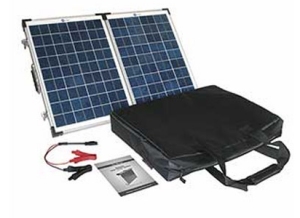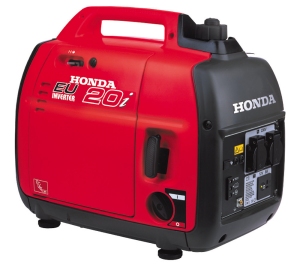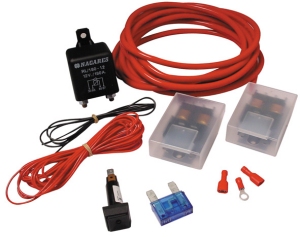Advertisement
Features Index > Caravanning Help and Advice > Leisure Battery Care and Charging
Leisure Battery Care and Charging
|
There have been many questions concerning batteries on our forums, and
UKCampsite.co.uk Member "Bailey
Oklahoma" has compiled the following article to help all those that are
confused or in doubt, stating he has explained the basics only to avoid
confusion. Please note these are the words and opinion of the author only, and you should
seek professional assistance if in doubt.

Types of Battery
- Flooded – These batteries have a conventional liquid electrolyte (Lead acid).
Standard types have removable caps so that de-ionised water can be added.
Standard flooded batteries are cheap and if they are kept topped up they are not
overly sensitive to high charging voltages. Sealed batteries have fixed valves
to allow gases to vent during use.
- Gelled Electrolyte – The electrolyte is a jelly and so will not leak. The
electrolyte cannot be diluted so that over charging must be avoided and these batteries may only last for 2 or
3 years in hot climates although with good care they can last for 5 years.
- Absorbed Glass Mat (AGM) Batteries – The electrolyte is held between the
plates absorbed in a fine boron-silicate mat. Like gelled electrolyte batteries
they will not leak acid but they can withstand more careless treatment and are
less sensitive to over charging since they are designed to retain vented gases.
AGM batteries can also stand for 30 days in a totally discharged state and still
be recharged successfully. The major drawback to these batteries is that they
cost between 2 or 3 times as much as flooded batteries
|
Battery Care
At least annually thoroughly clean the battery tray, terminals and connectors
and smear the latter with petroleum jelly. Unless sealed for life, remove the
battery vent plugs or strips and shine a torch into each cell to check the
liquid level, which should cover the top of the plates.
If the plates are exposed, top up with distilled or de-ionised water ONLY.
A digital voltmeter is the easiest way to check the voltage across the battery
terminals.
The chart opposite is a guide to the state of a battery.
Charging Sealed Batteries
|

|
|
Some batteries, often called 'maintenance free' or 'sealed for life', have cells
that have no filler caps, and which are not intended to be topped up with water.
It is important that such batteries are not allowed to 'gas' since this will
reduce the level of the electrolyte in the cells, which cannot be topped up.
|
 |
It is known that 'gassing' commences when the voltage at the terminals of the
battery rises above a level which for most batteries is around 14.1 Volts. Below
this voltage there is negligible gassing. It is therefore important with such
batteries that the voltage at the battery terminals is kept below this value.
Such batteries are preferably charged with an automatic or voltage controlled
battery charger. Sealed batteries can be charged with care using a normal
battery charger but this then requires the use of a multimeter.
Maintenance-free batteries frequently appear to be completely sealed. However,
like standard batteries, they do have openings for the release of gases.
|
How to avoid overcharging a battery
Never leave your battery connected to a caravan charger for more than the time required except when using a C-Tek charger (See Below) or similar. Although the caravan charger system is sufficient, the technical disadvantage is it never fully charges the battery to its full capacity. The charge voltage is cut off prematurely at 13.85 volts. Whichever type of battery you use, the in
built charger will give a maximum charge to within 80% of the batteries original
capacity. Over a period of time, this can cause sulphation of the plates in
leisure batteries, due to under charging. Over charging occurs when the battery
remains on charge after it has reached full charge (14.40 volts). Overcharging
causes excess heat that can cause the plates within the cells to buckle and
shred their active material. The battery will also react to the overcharge by
producing excess hydrogen and oxygen as the water within the electrolyte breaks
down. The water that is lost due to overcharging can be replaced in a non-sealed
battery. In a sealed battery, the water loss is permanent and will drastically
shorten battery service life.
All batteries are manufactured to provide a certain number of deep discharge
cycles. A cheap battery should give a cycling life of between 20 - 300 deep
discharges if you're lucky. A Gel battery will give between 400 - 500 cycles and
an AGM battery 600 - 800 cycles. A battery with a 5 year plus guarantee will
generally give 1000 plus cycles.
If the battery was left discharged for a week or so, it is likely that it has
become sulphated. This means that a permanent change has taken place, which may
render the battery totally useless. A sulphated battery is scrap and will not
hold a charge. In any event, a battery will not last forever and its life will
depend on how well it is maintained and how often used. Another type of leisure
battery made by some manufacturers uses carbon fibre in its construction, which
is claimed to inhibit sulphation and will therefore give an improved performance
and enhance its active life.
Always re-charge a battery after use and if the caravan is to be stored for more
than one month, ensure the battery is removed and stored in a fully charged
condition in a cool, dry place. Check every two months and re-charge if
necessary to ensure long and trouble free battery life. A battery left below
12.4 V will deteriorate quickly and will not be able to be recharged to its
original capacity. If charging the battery when removed from the caravan, ensure
that the premises are well ventilated, and do not smoke nearby otherwise BOOM.
The latest electronic chargers mostly make use of the IUI charge profile for
lead acid batteries. This means that the current drawn by the batteries is
allowed to flow at a constant (I) rate while the voltage is allowed to rise of
its own accord, which it will do as the battery starts to be charged up. This
first part of the charging cycle is known as the bulk charge phase. When a
preset voltage has been reached, normally the voltage at which the batteries
just start to gas, the charger will switch into the constant voltage (U) phase
and the current drawn by the battery will gradually drop until it hits another
preset level. This second part of the cycle is really the finish charge where
the battery just topped up to the brim very carefully at a much gently
diminishing rate. Finally the charger will switch again into the constant
current mode (I) and the voltage is allowed to rise again, up to a new higher
preset limit, in order to achieve a successful equalization charge.
Self Discharge
In time a battery will lose its charge, even with no equipment attached. Modern
batteries lose 0.1 to 0.2% of their charge per day at room temperature, even
when new - hence a newly purchased battery may not be fully charged. As
batteries age or temperature increases, so does the self-discharge rate.
Storage also affects the rate of discharge. A battery should never be stored
directly on the ground and especially not on concrete. The best storage method
is wooden pallets which do not conduct or allow damp paths and do allow good air
circulation. During storage, most manufacturers recommend a freshening charge
once every two months or so.
|
Which Battery Charger Should I Buy?
A proven and good charger is well worth paying out for, and an example is the C-Tek range, and the one used by most caravanners is the following :-
The Ctek CTE-XS3600 4 Stage Battery Charger is a switch mode charger with pulse maintenance for lead-acid
batteries between 1.2 Ah to 120 Ah and is one of a series of professional chargers from CTEK. It
represents state-of-the-art technology within battery charging. A Ctek CTE-XS3600 will prolong the service life of your battery.
|
 |
This carries out the following charging operations :-
Bulk - Charging where 80% of the energy is returned. The charger delivers an
almost constant current until the battery voltage reaches maximum level.
Absorption - Charging up to almost 100%. The charge current falls and the
voltage is kept constant at the maximum level.
Pulse - Maintenance phase, where the charger delivers a pulse if the battery
voltage drops.
Charging varies between 95% and 100%. The battery receives a pulse when the
voltage reduces
keeping the battery in good condition when not in use.
This charger can be connected for months.
MULTI XS 3600 Automatic Mode
This charger begins charging with an almost constant current (0.8A or 3.6 A)
until maximum voltage (14.4 V or 14.7 V) is reached.
The charger changes mode at this point. It locks the voltage at maximum level
and allows the current to drop. The MULTI XS3600 switches automatically to pulse
maintenance charging when the current drops to 0.4 A. The charging cycle
restarts if the battery voltage drops to 12.8 V or 12.9 V .
If the charger lamp and the maintenance-charger lamp are flashing alternately,
the reason for this is due to:
- An interruption during charging, due to a loose connection or because the
battery has ceased to work.
- The battery has become sulphated. If the lamps flash for more than 30 minutes,
this indicates that the battery is dead and needs to be replaced.
- If there is an interval of more than 10 seconds between the flashes, this
indicates that the battery has a high self-discharge rate and may need to be
replaced.
There is an additional feature incorporated, that on mains failure or
unplugging, the C-Tek will ‘remember’ what it was doing and resume its settings
when the mains power is restored.
From the above information, you can see why it is one of the most popular
chargers.
I have replaced the on board factory fitted charger with the C-Tek, and the
battery is six years old.
|
Charging with Solar Panels
Solar panels are an ideal way to charge a battery. There are many different
types of solar panels available from the inexpensive to the top of the range.
They have improved considerably in the last few years offering practical power
in compact sizes. Once installed, they require little or no maintenance allowing
you to enjoy your leisure time knowing that you will always have sufficient
power when it is required. A regulator is required with any solar panel above 22
watt. The regulator switches to pulse charging when the battery is 95% charged
and turns off completely when charge is completed, turning on again only when
required to keep the battery topped up.
|
 |
Charging with Generators
There are many different types of generators widely used, which offer a quick
solution to charging a low/flat battery.
Whilst using the generator to charge your battery, always ensure the electrolyte
is above the plates. If your battery is low on electrolyte, you can
inadvertently damage the plates of the battery and cause premature failure of
the product. It is not advisable to leave your generator continually connected
to the battery. Always disconnect the generator when the battery is fully
charged, and follow the manufacturers guidelines on safety, (Important: To
ensure no damage to batteries is sustained whilst charging with a generator, use
a Multimeter to check charging voltage when
14.40V is reached, switch off the generator).
|  |
Charging a battery in the boot of a car
Caravanners used to move their leisure battery into the back of the tow car to
achieve a higher charge rate from the alternator. The caravan battery or a spare
battery can be recharged simultaneously with the car battery from the car's
alternator and the most effective place to locate the caravan battery is in the
car boot. (The shorter cable run, and the use of a larger cable, results in a
greatly increased charge rate over a battery situated in the caravan).
The battery should be connected in parallel with the car battery that is the
positive terminals are connected together, as are the negative terminals. |
Batteries should not be left connected unless on charge or they will attempt to
equalize and so discharge one another. It is therefore essential to fit some
device which will automatically disconnect the caravan battery when the car
ignition is switched off.
A split charge relay is the most effective method and is suitable for all types
of vehicle alternators. The relay will come with installation instructions
including the size of cable that can be used. Ideally the caravan battery should
be enclosed in a box fixed to the boot floor.
With the engine and ignition switched off, the relay isolates the car battery
from the caravan battery. When the engine is started or the ignition switched on
(depending on the method of relay connections) the batteries are connected
together and will receive a charge. If your battery has a venting tube, make
sure this is routed to the outside of the vehicle.
|  |
|
A battery charged or stored
in the boot of a car must be secured in a suitable frame; if a battery were to
overturn the acid would be a serious safety hazard. Even a 'sealed' battery has
vent tube which would allow the acid to escape.
|
Disclaimer
Please note these are the words and opinion of the author only. Neither the author nor the website can be held responsible for any errors or omissions. You should seek professional assistance if in doubt. The article contains links to Amazon where you can buy all of the products mentioned.
|
|
Index : Caravanning Help and Advice : Leisure Battery Care and Charging - by UKCampsite.co.uk
Latest News, Discounts and Competitions see all...
|
3782 Visitors online !
Free UKCampsite.co.uk Window Sticker - Recommend to Friend - Add a Missing Campsite
[Message Forums]
[Caravan Sites & Camping]
[Company Listings]
[Features / Advice]
[Virtual Brochure]
[Special Offers]
[Reception]
[Competitions]
[Caravans & Motorhomes For Sale]
[Event Diary]
[Contact Us]
[Tent Reviews]


Please note we are not responsible for the content of external sites & any reviews represent the author's personal view only. Please report any error here. You may view our privacy and cookie policy and terms and conditions here. All copyrights & other intellectual property rights in the design and content of this web site are reserved to the UKCampsite.co.uk © 1999 - 2025 |

Advertisement
|
|
Advertisement
|












